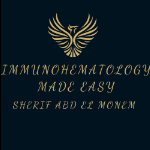Immunohematology Reference Laboratories
511 topics in this forum
-
An example of Anti-G Separation/Differentiation - Any thoughts? Thank you! Anti-C.-D.-G separation.HEIC
- 4 replies
- 860 views
- 1 follower
-
Hi all, I am happy to use a negative enzyme result to exclude Rh antibodies. However, I have a nagging doubt about being able to do this with anti-Cw but can't find any reference to this. Have I made this up or can anyone point me to where I can find this in black and white. Cheers, Rich
- 3 replies
- 475 views
-
Due to the recurrence of requests for Direct Antiglobulin Test (DAT) and, if positive, to perform the Eluate for patients with suspected Autoimmune Hemolytic Anemia (AIHA), I come here in the hope of obtaining answers or ideas from the specialists in this group. I understand the purpose of performing DAT (IgG/IgA/IgM and C3) to confirm cases of clinical suspicion of AIHA and/or to monitor an ongoing hemolytic process. But I wonder: What additional information can be obtained from the elution of red blood cells where IgG has already been detected? I understand the importance of the Eluate in the transfusion context, but knowing the methodological limitatio…
- 5 replies
- 3.1k views
- 1 follower
-
I would like to hear what positive and negative controls are being set up when you do a titer on pregnant patients. Are if any controls are being done at all. Thanks!
- 12 replies
- 2.9k views
- 1 follower
-
We have Received sample from Antenatal for G/S and found patient has Anti Yta confirmed by reference lab. I know Anti Yta doesn't cause HDFN however in terms for providing blood do we need Yta beg blood? Does this causes HTR if not provided Yta neg blood in an emergency?
-
- 1 reply
- 447 views
-
-
Hello everyone, Here is a new 100% educational opportunity (with PACE credits) for those who are interested in FNAIT. Here is the link to register Webinar | Bio-Rad
-
- 0 replies
- 462 views
-
-
Hello everyone, I have got the following questions a couple of times I was not able to answer, so I try my luck: would someone know why ficin is more often used in the US while papain is more commonly used outside the US? Both do have similar mode of actions, but I cannot figure out this geographical difference. European manufacturers mostly provide papain treated cells whereas US manufacturers ficin treated cells as far as I know (I might not be 100% right though). Had it to do with sourcing? User expectations? Practices (I believe the AABB technical manual refers to either ficin or papain..)? Thank you for the assist 😊
- 2 replies
- 955 views
- 2 followers
-
I thought for the first time I would share one of the educational webinars we have been producing with the ISBT because it is a fascinating topic addressed by a great lecturer (Sue Johnson). So do miss out on the opportunity to watch the recording of this ISBT educational webinar Could it be drugs? How to differentiate AIHA from DIIHA Start zoom webinar | The International Society of Blood Transfusion (ISBT)
-
- 0 replies
- 670 views
-
-
A research team led by NHS Blood and Transplant scientists based in Bristol, at NHSBT’s International Blood Group Reference Laboratory (IBGRL), and supported by colleagues at the University of Bristol, has discovered a new blood group, MAL. 🙌 🩸 They identified the genetic background of the previously known but mysterious AnWj blood group antigen, thus allowing identification and treatment of rare patients lacking this blood group. Louise Tilley, Senior Research Scientist, IBGRL Red Cell Reference at NHS Blood and Transplant, said: “The genetic background of AnWj has been a mystery for more than 50 years, and one which I personally have been trying to r…
- 2 replies
- 1.1k views
-
So, my manager (I'm the asst. mgr) has me looking at ALL our reagent IFU's to make sure that our SOP's are in line with the IFU's since this new FDA thing is coming up stating that anything used outside of the IFU is an LDT.....(or something to that effect). We are a large academic medical center and do 95+% of our own abid's. As I'm reading these IFU's for screen and panel cells they are all saying "Do not use beyond expiration". We often use expired panel cells to help R/in or R/out antibodies - does this new ruling mean that we can no longer do that....? Even if we run +/- controls? I'm stressing just a little! We also freeze some of the more "rare" antiseras…
- 4 replies
- 1.2k views
- 2 followers
-
Is it just me that has missed it???????? I visited the ISBT site yesterday, and noticed that the Cost Blood Group Collection of Cs(a) and Cs(b) is no longer a Collection, but that the two antigens have been "promoted" to the CTL2 Blood Group System. I THINK that this is a recent happening. Can any member put forward a reference concerning this, as I have been unable to track anything down on Google (mind you, I hold both hands up to me being monumentally useless at driving a computer!!!!)??? Thanks in advance.
- 2 replies
- 848 views
-
Hello Everyone, This is my first time posting, however, I have been creeping on this forum for quite some time and learning a ton! We have a premature baby boy delivered at ~28 weeks that was born at an outside hospital and immediately transferred to us for support. I will list below our test results and the results on mother too (we had blood drawn on mom since the delivering hospital did not have any blood bank testing done). I am curious of any reason for how these results could happen and why LISS testing is the only negative results we are getting. Background - 12 day old (30w3d), Black male - Delivered at outside hospital (OSH) at 28w5d gestation v…
- 7 replies
- 1.6k views
-
We have a 63 year old female, never transfused, 4 children, generally healthy until a few weeks ago, who came in with a 6.7 hemoglobin. Our work up looked like a warm auto, so off it went to the reference lab. It’s not a warm auto. She has anti-Sciana 3! We tested 2 sisters, a brother, and a son and she is incompatible with everyone. Meanwhile samples are in process for MMA testing as well as a search of the rare donor registry. Her hemoglobin has dropped to 5.1 and doc wants to perform a bone marrow to try and figure out what’s going on. She also has a DVT that needs a procedure but doc won’t touch her until she can get some blood. The MMA results will not be available …
- 3 replies
- 719 views
-
Can the autocontrol is positive , negative with cell of antibody screening cells and compatible cross match with RBCs units ?
- 5 replies
- 5.3k views
-
Does anyone have a procedure for pulling apart a panreactive weak IAT panel?
- 6 replies
- 2.7k views
- 1 follower
-
Hello Patient has developed antiD in first pregnancy at around 32 weeks and her quantification level was 1.0 IU/ml. In 2nd pregnancy her booking blood at (12 weeks) antibody screening was negative. At 15 weeks sample sent for fetal genotype (FDS). On this Report received inconclusive due to all Anti D. Because patients was on file for historical antibody therefore sample sent for quantification in 2nd pregnancy and Report received antibody not quantified since it reacted weakly in enzyme IAT only. My understanding standing is if patients once developed Allo antiD her titre level does not go down. Why was her antibody screen was negative in 2nd preg…
- 8 replies
- 1.7k views
-
I'm over my head with this case for a Friday afternoon. Patient is a 70 yo apparently Caucasian female who was transfused in 1981 in childbirth. No transfusion since. She was in ED for a fall but has been discharged. Very limited sample volume. O pos. Appears to have anti-C reacting 1+ in gel. Reacts 1+ with another cell that is C neg and HLA pos. HLA is noted as present on 2 of the C+ cells that react but not on the other three C+ cells that react. Have negative reactions that allow ruling out all of the other usual suspects. DAT is 3+ with IgG; neg for Complement. Patient types C+, E+, c+, e+ with the e reacting quite a bit more strongly than is typical with ou…
- 11 replies
- 3.1k views
- 1 follower
-
Hi, Does anyone have a way to freeze reagent red cells that does not involve Glycerolyte 57, liquid nitrogen or glycegel. we currently use Glycerolyte57 but can only order it by the case and usually only use one bottle a year. Thanks,
- 4 replies
- 1.7k views
-
I PUT THIS Q IN TRANSFUSION SECTION BUT I GUESS MORE RELEVANT HERE. We recently had an antenatal case which showed some unusual features. This was the third pregnancy, the first miscarried at less than 10 weeks. The second was delivered after a seemingly uneventful pregnancy. At booking we found enzyme anti-f. At 28 weeks anti-f, anti-K and a further unidentified Ab. (f and K enzyme only). By 32 weeks She also had anti-Fya and possibly Cw. From 38 weeks gestation we kept 4 R1R1 K- Fya- units crossmatched in case of emergency. These were compatible. 4 days later the sample had a positive DAT and all units were incompatible. The patient delive…
- 23 replies
- 5.1k views
-
Hello Fellow BB'ers! We have somewhat of a mystery! We have a patient who developed an anti-K about 6+ months ago. At the same time they were also demonstrating what appeared to be a warm auto in their eluate (eluate positive with all cells). We allo-adsorbed and found the anti-K in their adsorbed eluate as well. Ok - not unheard of........... Jump forward to present............ This patient has been receiving K neg RBC transfusions - maybe x2 every other week - since the anti-K was discovered. Our protocol requires us to repeat DAT on each visit when suspected warm autos were detected....until he DAT is negativ. The DAT has consistently been positive (2-3+ …
- 12 replies
- 2.5k views
- 2 followers
-
Hello, I'm from the Netherlands and my coworkers always references a freeze-thaw elution as lui eluate. But the thing is, no one has a clue what it stands for. We use the Lui (freeze-thaw) elution technique for diagnostics in AB0 incompatibility with mother/child. Could someone explain what "Lui" stands for? Is it a name? Is it an abbreviation? Thank you in advance. Roman
- 4 replies
- 2.5k views
-
We provide a long term frozen storage facility in South Africa for rare blood donations to be used for transfusion purposes. These donations are currently stored using a high glycerol solution and stored at -80 degrees C. We have been having difficulty with the supply of the glycerol solution required for this procedure. My aim is to find out what methods other institutions are using for this facility and where they obtain their supplies from. Any input would be greatly appreciated.
-
- 1 reply
- 2.3k views
-
-
We received Antenatal patient sample at 38 weeks gestation. Antibody screen was negative at 28 weeks ant patient blood group is A Rh D positive. Now at 38 weeks patient Screening cell is positive with 2 lines(2+) therefore antibody identification was performed. But panel shows negative with all 10 cell by IAT and papain. My question is should we have to send sample to RCI for antibody conformation if blood is required for transfusion or we just can just provide ABO and D and Rh compatible blood IAT xmatch?
- 12 replies
- 2.3k views
- 1 follower
-
Hello everyone. At the AABB annual meeting I heard there is available a soluble CD38 substance that can be used to neutralize the anti-CD38 from therapy that interferes with routine antibody detection. I love the idea of not having to use DTT anymore since it is a very noxious chemical. Does anyone have experience with this method they would be willing to share? I am guessing it must be costly or most labs would be using it? Thanks in advance.
- 9 replies
- 3k views
-
Please help me in calculation: Need to find one antigen negative unit for patient whose blood type is B positive. Need C-, K-, Fya- and Jkb- unit. We want to use only B negative and O negative units so I want frequency based on that. Please demonstrate how you got the answer Please...Thanx
- 25 replies
- 42.6k views
- 1 follower









